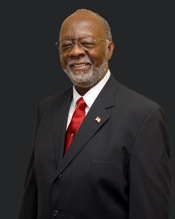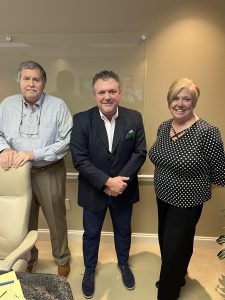If a resume shows the figurative size of a person’s heart, William ‘Bill’ Lockett may have the biggest one in the room. He’s retired from the military and as a federal investigator, high school teacher and elected county commissioner. Each job required its own skills and taught Lockett valuable life lessons he uses today.
With that, it’s no surprise that Lockett’s heart is literally larger than normal. While that sounds nice on paper, it’s been an issue he has dealt with for years.
Lockett was diagnosed with an enlarged heart and hypertension almost 40 years ago, and believes he’s been able to reach his 84th birthday thanks to Augusta University Health’s Chronic Care Management program.
The chronic care program at AU Health is done in partnership with NavCare, which specializes in treating those with chronic illnesses.
Lockett has been going to AU Health for years and credits Dr. Janis Coffin, a family medicine specialist with AU Health and professor with the Medical College of Georgia, with his continued good health. He said through Coffin and the chronic care program, someone always checks in to make sure he’s doing what he needs to.
“I know they’re going to get in contact with me. If they can’t get me by telephone, they’ll send me an email and sometimes even bring up things I’d forgotten,” said Lockett.
Those getting in contact with Lockett and thousands of other chronic care patients around the city are specialists at NavCare.
NavCare’s focus is on care management, specifically with remote monitoring, virtual telehealth, chronic care and transitional care. They work with physicians and patients to manage medications, arrange any transportation or home-based needs and check the patients’ conditions as needed.
Typically, patients are identified by their physicians at AU Health for the program. They will have two or more chronic conditions ranging from congestive heart failure to diabetes and COPD, have seen their physician within the last year and are typically in a Medicare or Medicare Advantage Program.
“We really saw remote patient monitoring grow tremendously and monitoring patients in their own home,” said Theresa Lantz, Executive Vice President of NavCare. “By working with AU Health on this and its hospital at home program, we’re getting patients out of the hospital quicker and freeing beds up to allow other patients to come in.”
Lantz points to industry stats that show the importance of a solid chronic care management program. About 80% of decisions for chronic care are made outside of the health care provider’s office. For every 1,000 patients NavCare interacts with, 47 ER visits and unnecessary hospital stays are avoided. Lantz said these numbers demonstrate that the program is helping more patients focus on quality life instead of quantity.
“It’s a true proactive approach to health care versus being reactive,” said Lantz.
The average NavCare patient is 79 years old, has multiple comorbidities and lives on a fixed income. NavCare Chief Operating Officer Chris MacInnis said these patients need the latest in health literacy and help navigating the healthcare system.
“We’re really about quality care, low cost and patient experience, because if we don’t do a good job in those and aren’t adding value, the patient and provider won’t stay on service,” said MacInnis.
MacInnis and Rick Griffin, CEO of NavCare, liken how NavCare and AU Health operate to a checks and balances system.
“Any community-based care is still driven by the physician, but the introduction of technology in the home and in community-based care is a watershed event. This broadens the ability to supply care outside the hospital setting, and makes our health care system much more efficient,” said MacInnis.
For the thousands of chronic care patients at AU Health, NavCare’s base in Augusta provides an added benefit: relationships.
“Sometimes the distance to hospitals we contract with creates challenges. With AU Health in our backyard, we can walk over and meet with someone face-to-face working on this program. Our ability to tailor the protocols and what the patient population need really help,” said MacInnis.
Lantz also saw how these programs can help first-hand. Her in-laws lived alone and their health was declining. She didn’t know what was going on behind closed doors, but trips to the hospital were constant.
They totaled around 36 EMS stays and 11 hospital stays, all due to low blood sugar, inconsistent mealtimes and poor exercise habits.
Once the two moved in with Lantz, they were put into the chronic care program. Lantz said the transformation she saw in her mother-in-law was shocking.
“Zero hospital stays in five years. She was doing her routine physician appointments and was completely mobile. It’s all from monitoring medications, making sure we are checking vitals and following up on a physician’s plan. It’s what we do every day,” said Lantz.
Lockett sees that, too. He is used to the calls checking in on him and knows it’s made a huge difference in his health today.
“These doctors care about you. My relationship with Dr. Coffin isn’t just patient-doctor, but it’s a friendship. When you have that much confidence in that person, I know they want to do their job,” said Lockett. “It’s not easy getting in touch with a doctor, but the program helps me fill prescriptions, they’re professional, and are there 24/7. That’s the way you keep satisfied customers, and I’m one.”




